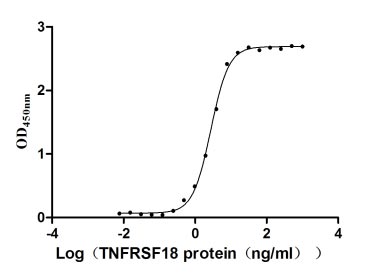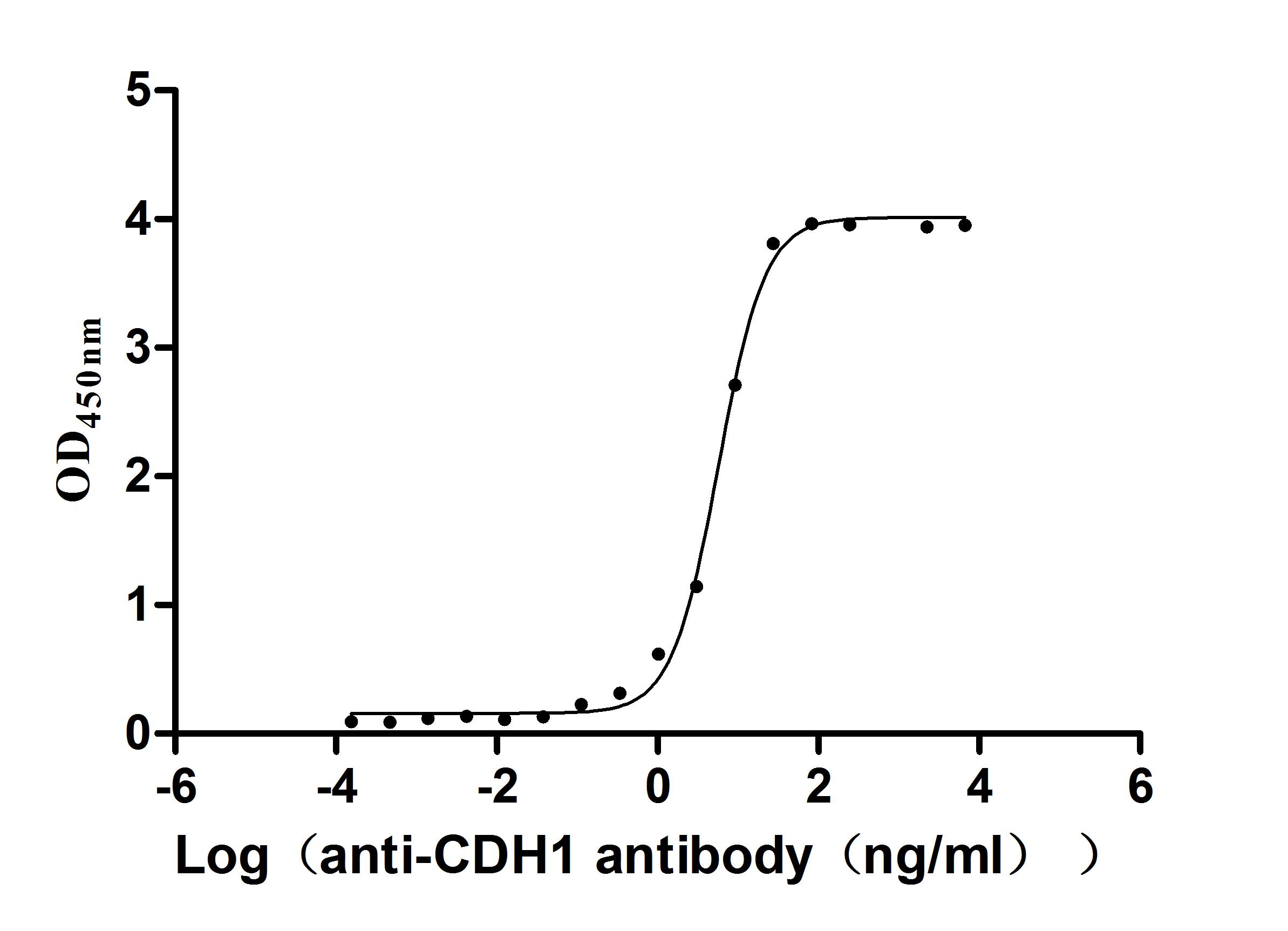Recombinant Human Platelet-activating factor receptor (PTAFR)
-
货号:CSB-CF018946HU
-
规格:
-
来源:in vitro E.coli expression system
-
其他:
产品详情
-
基因名:
-
Uniprot No.:
-
别名:PTAFR; PAFR; Platelet-activating factor receptor; PAF-R; PAFr
-
种属:Homo sapiens (Human)
-
蛋白长度:Full length protein
-
表达区域:1-342
-
氨基酸序列MEPHDSSHMDSEFRYTLFPIVYSIIFVLGVIANGYVLWVFARLYPCKKFNEIKIFMVNLT MADMLFLITLPLWIVYYQNQGNWILPKFLCNVAGCLFFINTYCSVAFLGVITYNRFQAVT RPIKTAQANTRKRGISLSLVIWVAIVGAASYFLILDSTNTVPDSAGSGNVTRCFEHYEKG SVPVLIIHIFIVFSFFLVFLIILFCNLVIIRTLLMQPVQQQRNAEVKRRALWMVCTVLAV FIICFVPHHVVQLPWTLAELGFQDSKFHQAINDAHQVTLCLLSTNCVLDPVIYCFLTKKF RKHLTEKFYSMRSSRKCSRATTDTVTEVVVPFNQIPGNSLKN
Note: The complete sequence including tag sequence, target protein sequence and linker sequence could be provided upon request. -
蛋白标签:N-terminal 10xHis-tagged
-
产品提供形式:Liquid or Lyophilized powder
Note: We will preferentially ship the format that we have in stock, however, if you have any special requirement for the format, please remark your requirement when placing the order, we will prepare according to your demand. -
缓冲液:Lyophilized from Tris/PBS-based buffer, 6% Trehalose, pH 8.0
-
储存条件:Store at -20°C/-80°C upon receipt, aliquoting is necessary for mutiple use. Avoid repeated freeze-thaw cycles.
-
保质期:The shelf life is related to many factors, storage state, buffer ingredients, storage temperature and the stability of the protein itself.
Generally, the shelf life of liquid form is 6 months at -20°C/-80°C. The shelf life of lyophilized form is 12 months at -20°C/-80°C. -
货期:Basically, we can dispatch the products out in 1-3 working days after receiving your orders. Delivery time may differ from different purchasing way or location, please kindly consult your local distributors for specific delivery time.Note: All of our proteins are default shipped with normal blue ice packs, if you request to ship with dry ice, please communicate with us in advance and extra fees will be charged.
-
注意事项:Repeated freezing and thawing is not recommended. Store working aliquots at 4°C for up to one week.
-
Datasheet & COA:Please contact us to get it.
相关产品
靶点详情
-
功能:Receptor for platelet activating factor, a chemotactic phospholipid mediator that possesses potent inflammatory, smooth-muscle contractile and hypotensive activity. Seems to mediate its action via a G protein that activates a phosphatidylinositol-calcium second messenger system.
-
基因功能参考文献:
- he PAFR gene rs5938 or rs313152 polymorphisms might be a potential biomarker for susceptibility to coronary heart disease. PMID: 28197937
- Weighted gene co-expression network analysis of gene modules for the prognosis of esophageal cancer yielded PTAFR and FGR as the most important hub genes for predicting patient survival. PMID: 28585144
- we demonstrate that PAFR inhibition can selectively enhances the sensitivity of radiotherapy in prostate cancer cells with elevated PAFR expression after irradiation exposure PMID: 28099922
- PAFR overexpression is associated with pneumococcal infection. PMID: 28278175
- WEB-2086 represents an innovative class of candidate drugs for inhibiting PAFr-dependent lung infections caused by the main bacterial drivers of smoking-related COPD. PMID: 27524890
- PAF stimulation dose-dependently promoted the invasion, migration and growth of prostate cancer cells in vitro, while knockdow our findings demonstrate that PAFR can activate ERK1/2 pathway, and subsequently increase MMP-3 expression and decrease E-cadherin expression PMID: 27176648
- PAFR is overexpressed in NSCLC as well as in breast, colorectal, and gastric carcinomas. PAFR expression correlates with clinical stages, survival time, and distant metastasis. PAF/PAFR signaling also upregulated IL6 expression and STAT3 activation. PMID: 26359459
- we made the first demonstration that dysregulation of PAFR and the positive regulatory loop between PAFR and pAKT contribute to malignant progression of esophageal squamous cell carcinoma PMID: 25639872
- Data support an important role for PAFR in tumor growth and suggest that engagement of PAFR interferes with selected pathways in macrophages, changing their phenotype into that of a regulatory with suppressor activities. [review] PMID: 25182608
- Epithelial PAFr expression is upregulated in smokers, especially in those with COPD, and is not obviously affected by inhaled corticosteroid therapy. PMID: 25143722
- Results suggest that WEB2086 and AG1478 are synergistic in ovarian cancer cells with high expression of both platelet-activating factor receptor (PAFR) and epidermal growth factor receptor (EGFR). PMID: 24886678
- PAFR may have an important role in modulating the cisplatin sensitivity of ovarian cancer cells. PMID: 24921917
- patients presenting elevated PAFR expression had significantly longer survival times compared to those with low PAFR expression (log-rank test, p<0.001). PMID: 24824933
- oxLDL induces the recruitment of PAFR and CD36 into the same lipid rafts, which is important for oxLDL uptake and IL-10 production PMID: 24130805
- Data suggest PAF/PAF receptor signaling exerts proinflammatory effect on neutrophil via down-regulation of LXRa (liver X receptor alpha) and target genes (ATP-binding cassette transporter (ABC) A1, ABC G1, sterol response element binding protein 1c). PMID: 24289152
- Inhibition of platelet aggregation by lipoteichoic acid was blocked using a monoclonal anti-PafR antibody and Ginkgolide B,a well-defined PafR antagonist, demonstrating that the LTA inhibitory signal occurs via PafR. PMID: 23911710
- oxLDL induces alternative macrophage activation by mechanisms involving CD36 and PAFR PMID: 24062612
- Data suggest that expression of PAFR and SIRT1 (sirtuin 1) is down-regulated in endothelial progenitor cells of type 2 diabetic patients with poor glycaemic control compared to those with good glycaemic control. PMID: 23070058
- An implication of platelet-activating factor receptor A224D mutation in the susceptibility to relapsing-remitting multiple sclerosis in Tunisian population. PMID: 21658861
- recognition of apoptotic cells by phagocytes leads to activation of PAFR pathways, resulting in a microenvironment response favorable to melanoma growth PMID: 22577252
- PAFR may have a role in tumor response mechanisms, such as stress responses caused by chemotherapeutic agents PMID: 22570511
- Eosinophils use their platelet-activating factor receptors (PAFRs) to interact directly with Staphylococcus aureus. PMID: 22595142
- Pneumococcal ligands keratin 10, laminin receptor and platelet-activating factor receptor are elevated in aged lungs and contribute to the enhanced susceptibility to pneumonia. PMID: 21615674
- Urban particulate matter (PM) increases adhesion of S. pneumoniae to human airway epithelial cells. PM-stimulated adhesion is mediated by oxidative stress and PAFR. PMID: 21247619
- Platelet-activating factor plays a pivotal role in the oxLDL-induced recruitment of hBMSCs through mechanisms involving platelet-activating factor receptor dependent activation of Mitogen-Activated Protein Kinases. PMID: 21063106
- The expression of PAF receptor (PAF-R) in early endothelial progenitor cell and the release of PAF under stimulation with factors involved in endothelial dysfunction, were investigated. PMID: 20637897
- Results reveal that some strains of Gram-positive bacteria exploit hypoxia-inducible factor 1 alpha-regulated platelet-activating factor receptor as a means for translocation through intestinal epithelial cells. PMID: 20032301
- role in activation of mast cells by PAF. PMID: 20392487
- conserved proline in TM6 is crucial for intracellular trafficking of PAFR. PMID: 20007715
- activates the extracellular signal-regulated kinase mitogen-activated protein kinase and induces proliferation of epidermal cells PMID: 11861812
- Neuroblastoma clone cells show an inverse relationship between invasiveness and differentiative capacity and by the expression of specific cell surface PAF receptors. PMID: 11928813
- PAF receptor transcripts in five human cancer cell lines derived from the breast (BT20, SKBR3 and T47D cells), the pancreas (Miapaca cells) and the bladder (5,637 cells) confirm the existence of a splice variant of the PAF-R transcript 2. PMID: 12467527
- a novel pathway whereby the epidermal PAF-R can augment chemotherapy-induced apoptotic effects through an NF-kappaB-dependent process PMID: 12601006
- the epidermal platelet-activating factor receptor augments staphylococcal alpha-toxin signaling PMID: 12713583
- platelet-activating factor receptor is desensitized and internalized by coumermycin-gyrase B-induced dimerization PMID: 12756251
- PAFR degradation can occur via both the proteasome and lysosomal pathways and ligand-stimulated degradation is ubiquitin-dependent PMID: 14500726
- platelet-activating factor receptor-mediated signaling has a critical role in differentiated endothelial cell functions, including cell migration and proteolytic activation of MMP2 PMID: 14617636
- investigated whether the increase of uPA monocyte expression and chemokine releases induced by oxidised low density lipoproteins involved proinflammatory phospholipid products having platelet-activating factor-like activity via the PAFR pathway PMID: 15149885
- Analysis of 102 B-CLL patients revealed dramatic differences for their membrane PAF-R expression, a result that might be related to their plasma IL-4 levels. PMID: 15160913
- the PAFR gene missense mutation has a relation to the susceptibility for multiple sclerosis . PMID: 15748960
- UVB photo-oxidizes cellular phospholipids, creating PAF analogs that stimulate the PAF receptor to induce further PAF synthesis and apoptosis PMID: 16115894
- PAF induced CREB and ATF-1 phosphorylation via a PAFR-mediated signal transduction mechanism that required pertussis toxin-insensitive Galphaq protein and adenylate cyclase activity and was antagonized by a cAMP-dependent PKA and p38 MAPK inhibitors. PMID: 16306050
- presence of functional PAF-R in arterial spindle-shaped smooth muscle cells of synthetic phenotype may be important for their migration from the media into the intima and atherosclerotic plaques formation PMID: 16793019
- The functional PAF-R are present in blast cells of patients with acute leukemia; a result that could be of physiologic importance regarding the important effect of PAF on leukocytes maturation and functions. PMID: 16837045
- These studies suggest that SZ95 sebocytes express functional PAF-Rs and PAF-Rs are involved in regulating the expression of inflammatory mediators, including COX-2, PGE(2) and IL-8. PMID: 16984258
- epidermal PAF-R can modulate UVB-mediated early gene expression PMID: 17928889
- a lower expression of PAFR in HCC correlated with both poor differentiation and portal venous invasion. PMID: 18187960
- analysis of PAFR activation and pleiotropic effects on tyrosine phospho-EGFR/Src/FAK/paxillin in ovarian cancer PMID: 18632638
- cis-urocanic acid stimulates mediator production by a pathway that is independent of these serotonin 2A and PAF receptors in human keratinocytes PMID: 19474802
- PAFR is localized in lipid rafts and/or caveolae, a position that is important for proper coupling to downstream signaling elements. PMID: 19620302
显示更多
收起更多
-
亚细胞定位:Cell membrane; Multi-pass membrane protein.
-
蛋白家族:G-protein coupled receptor 1 family
-
组织特异性:Expressed in the placenta, lung, left and right heart ventricles, heart atrium, leukocytes and differentiated HL-60 granulocytes.
-
数据库链接:
HGNC: 9582
OMIM: 173393
KEGG: hsa:5724
STRING: 9606.ENSP00000301974
UniGene: Hs.77542
Most popular with customers
-
Recombinant Human Tumor necrosis factor receptor superfamily member 18 (TNFRSF18), partial (Active)
Express system: Mammalian cell
Species: Homo sapiens (Human)
-
Recombinant Human IL12B&IL12A Heterodimer Protein (Active)
Express system: Mammalian cell
Species: Homo sapiens (Human)
-
Recombinant Human C-C chemokine receptor type 8 (CCR8)-VLPs (Active)
Express system: Mammalian cell
Species: Homo sapiens (Human)
-
Recombinant Human Cell adhesion molecule 1 (CADM1), partial (Active)
Express system: Mammalian cell
Species: Homo sapiens (Human)
-
Recombinant Human Cadherin-17 (CDH17), partial (Active)
Express system: Mammalian cell
Species: Homo sapiens (Human)
-
Recombinant Mouse Cytotoxic and regulatory T-cell molecule (Crtam), partial (Active)
Express system: Mammalian cell
Species: Mus musculus (Mouse)
-
Recombinant Human Cadherin-1(CDH1),partial (Active)
Express system: Mammalian cell
Species: Homo sapiens (Human)
-
Recombinant Macaca fascicularis Cadherin 6(CDH6),partial (Active)
Express system: Mammalian cell
Species: Macaca fascicularis (Crab-eating macaque) (Cynomolgus monkey)




















